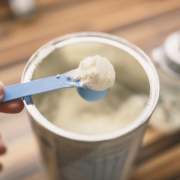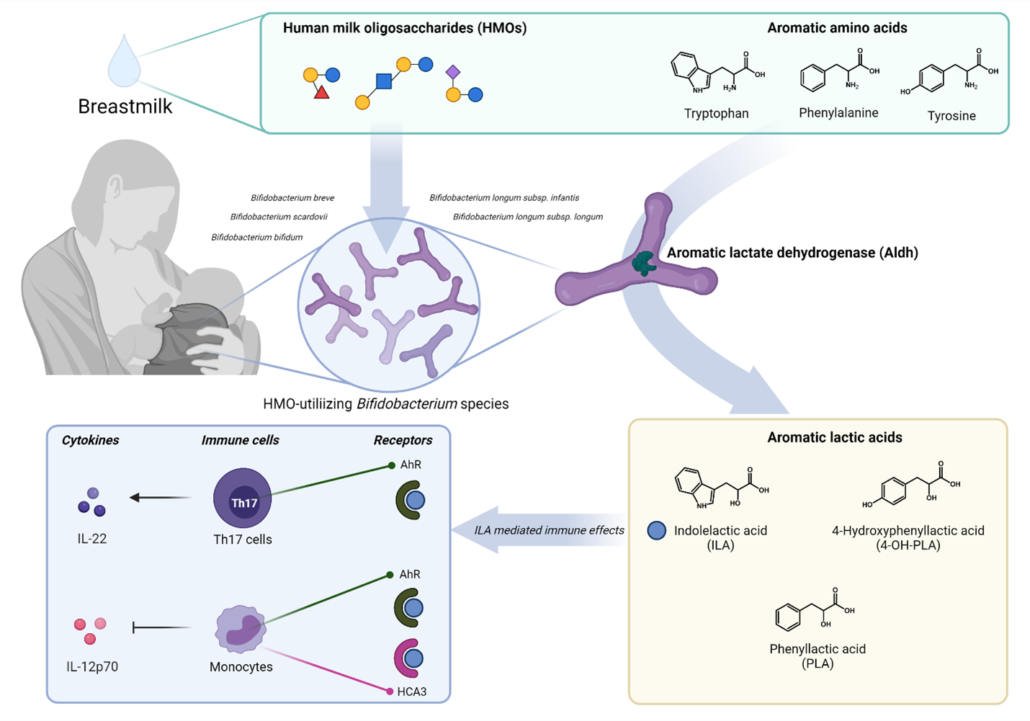The many functions of human milk oligosaccharides: A Q&A with Prof. Ardythe Morrow
Human milk is the ‘gold standard’ of infant nutrition—and some scientists have set their sights on working towards that standard to improve the health of infants who are not breastfed. Among the many important components of human milk are human milk oligosaccharides (HMOs): complex carbohydrates that are 3-32 sugars in length. Over 200 different HMO molecules have been discovered, but a mother typically has between 12 and 20 in her milk. Some types of HMOs are affected by genetic polymorphisms – for example, only those who have the FUT2 (secretor) gene have breast milk containing HMOs called 2′-fucosylated (2’-FL) glycans.
ISAPP held a webinar in October, 2022 featuring Prof. Ardythe Morrow, University of Cincinnati College of Medicine, speaking about the latest research on HMOs and their health effects in both infants and adults.
HMOs as prebiotics
Prof. Morrow emphasized that research to date on HMOs shows they clearly fit the scientific consensus definition for prebiotics: a “substrate that is selectively utilized by host microorganisms conferring a health benefit”. HMOs are utilized by bacteria in the infant gut—mainly bifidobacteria, but also other genera (Yu, Chen & Newburg, 2013)—producing end-products that benefit infant health. B. longum subsp. infantis are the quintessential bacteria that grow on HMOs; pathogens do not typically grow on them.
Within the prebiotic category, HMOs are unique. Unlike other prebiotic substances they are structurally similar to gut oligosaccharides, which populate the surface of mucosal surfaces of the GI tract and are abundant in the mucin layer. They also can function via mechanisms that do not require utilization by gut microbes.
Beyond prebiotic function
Prof. Morrow emphasized that HMOs are multi-functional agents: in addition to their prebiotic functions, they have direct functions in the infant gut that are not mediated by microbes. First, individual HMOs have been shown to bind pathogens and inhibit infections and bind to immune cells to optimize their function (Triantis, Bode & van Neerven, 2018). Further, they can enhance neurodevelopment and brain function (Furness, Kunze & Clerc 1999; Sharon et al, 2016). The latter is a more recent domain of research, but so far it is known that basic neurodevelopmental processes are modulated in animals that are germ-free or have a depleted gut microbiota.
Certain HMOs (notably 2’-FL) can be produced synthetically and are being tested in infant formulas, and more recently for healthy adults (Elison et al., 2016). Prof. Morrow noted HMOs also have potential as novel therapeutics for various indications, such as inflammatory bowel disease (IBD). Determining which specific HMOs are most effective in these outcomes, and the dose needed, is an active area of research.
The webinar participants generated some interesting questions, some of which Prof. Morrow answers below.
Are 2’FL and LNnT (Lacto-N-neotetraose) found in cow’s milk?
2′-FL is not found in cow’s milk. Other oligosaccharides, especially sialyl oligosaccharides, are present but generally at very low levels.
How similar to HMOs are the glycosylation patterns on gut mucin?
Mucin glycosylation is not identical to human milk. But there are structural motifs that recur in both milk and gut mucin.
Do the more abundant HMOs have more potential for health benefit, compared with those at lower abundances in human milk?
We do not know that more abundance means more functionality or importance. But it is a reasonable place to start with the research. Also, several of the most abundant HMOs are trisaccharides (2’FL, 3FL, 3′-SL, and 6′-SL), and these are the most manageable to synthesize and start with.
For non-secretors, HMO complexity in milk is around 30% lower than for secretors. Does this factor affect the beneficial functions of non-secretor HMOs?
Having lower HMO content might be an issue in some circumstances. But we cannot say that it is a general problem. Furthermore, if non-secretors have more sialyloligosaccharides and 3-FL instead of 2′-FL, for example, perhaps this helps protect against viruses that bind to sialic acid epitopes (for example, influenza). Or perhaps this helps with increasing sialic acid to the brain (see Mudd et al., 2017). So, my argument is that at this point in our knowledge, we should avoid any idea of “superior” or “inferior” milk for the general healthy public. More likely, there are situation-specific benefits or disadvantages for different milk oligosaccharide phenotypes.
What do you think is more important for infant formula, more HMO complexity or more structure-function relations?
A set of HMOs for normal infant nutrition will be important, and these include fucosyllactoses, sialyllactoses, and neutral oligosaccharide with neither sialic acid nor fucose. Structure-function orientation is important to guide use in special populations with specific health needs.
Long term, will HMOs replace FOS and GOS in infant formulas?
All of the efforts in making infant formula have the goal of doing the best possible job of mimicking the physiological function of breastmilk, but cost and function are also relevant factors to consider in this process. It’s important that babies get some form of prebiotic. GOS is structurally more similar to HMOs, but it’s not enough on its own. Ideally, we’d hope for a rational mixture of different oligosaccharides backed by research confirming their combined functions.
Can we really replicate HMOs with synthetic formula, given the large number of diverse HMOs present in human milk?
I do not foresee ever achieving full replication, no. But getting closer to mother’s milk, yes, over time.
How is the dosing of HMOs in clinical trials for adults being determined? Should it be based on human milk concentration?
Elison et al. published a dosing study based on tolerance and shift of microbiota. A dosing study is now underway in Cincinnati, too.
Since it is fairly difficult to manufacture HMOs, do you think they provide sufficient advantages compared to GOS to justify their use as prebiotics in adults?
We do not yet know whether HMOs might have enough advantage over GOS in some situations, or whether prebiotic combinations might be best. This is research in progress! The reason for testing 2′-FL in IBD is because of the structure-function evidence. IBD is increased in non-secretors, and is associated with dysbiosis, inflammation, and so on. We will learn from the ongoing research.
Do you think adults will differ in response to HMOs therapeutically, possibly based on genetic differences?
I don’t yet have data on this, but have a study ongoing that I hope will be able to address this very question.
Watch the recording of this webinar below:








